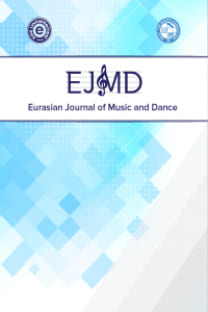KIRIM TATAR MÜZİK GELENEĞİNDE TAŞIYICI BİR UNSUR OLARAK KIRIM TATAR KADINLARI: “APAKAYLAR” ve “KARTANAYLAR”
THE CRIMEAN TATAR WOMEN AS A CONVEYOR COMPONENT IN THE TRADITION OF CRIMEAN TATAR MUSIC: “APAKAYS AND KARTANAYS”
The studies of musical/cultural identity includes two different basic subjects aswoman and man in the context of gender. According to the perception that isgenerally accepted , while these two different subjects are considered inhierarchical order, the men are appraised as the former or the anterior; the women,on the other hand, are appraised as the secondary or the posterior. The feminist approaches that have basically been developed as a reaction to this perceptionalhierarchical order aim to change this sense which is in the favor of the men bygetting the women to be taken up in the same level with the former.Women gender in the Crimean Tatar social life has not been abstracted from thesociety, restricted through hard norms or confined in any field. Especially, in termsof maintaining the musical tradition The Crimean Tatar women have taken part in avariety of musical performances from playing instruments to vocal forms anddances. The fact that the young women are called as Apakays and the old ones arecalled as Kartanays, accordingly with their age categories in the language of TheCrimean Tatar and these Tatar women have active roles in carrying and transferringtheir cultural identity by means of music constitutes the main topic of this article.The inadequate number of the written literature related to this topic has forced thearticle to the data that will be able to be obtained from the area and has limited itwith them. Therefore, this article has been formed in the light of the observations,interviews and music compilations in relation to the studies of this area performedin Turkey (Eskişehir, Çatalca and Ankara/ Polatlı) and in the Crimea Region of theUkraine.
Keywords:
Key Words: The Crimean Tatar women; Apakay; Kartanay; Musical/Cultural Identity; Cultural Maintanance Cultural Transfer,
___
- AGAT, S. (2002). Kırım Türkleri Halk Ounlları ve Geleneksel Giysileri. İstanbul: İstanbul Üniversitesi Sosyal Bilimler Enstitüsü Yayımlanmamış Yüksek Lisans Tezi.
- ALTUNTEK, N. S. (2009). Yerli'nin Bakışı Etnografya: Kuram ve Yöntem. Ankara: Ütopya Yayınevi.
- ASSMANN, J. (2001). Kültürel Bellek. İstanbul: Ayrıntı Yayınları.
- ATABEY, N. (2010, Mart 08). Şefika Gaspıralı ve ilk kadın dergisi “Alemi Nisvan” (Hanımlar Dünyası). Mart 03, 2015 tarihinde Haberiniz: http://www.haberiniz.com.tr/yazilar/koseyazisi7651-
- Sefika_Gaspirali_ve_ilk_kadin_dergisi_Alemi_Nisvan_Hanimlar_Dunyasi.html adresinden alındı
- AUERBACH, S. (2007). Şarkıdan Ağıta: Bir Yunan Köyünde Kadınların Müzikal Rolü. Dans Müzik Kültür / Folklora Doğru, 221-244.
- ERSOY, İ. (2010). Kırım Tatar Ritüeli Tepreş Ekseninde Diaspora Kimlik ve Müzik. İzmir: Ege Üniversitesi Basımevi.
- HABLEMİTOĞLU, Ş. H. (1998). Şefika Gaspıralı ve Rusya'da Türk Kadın Hareketi (1893-1920). Ankara: Ajans- Türk Matbaacılık.
- KARA, K. A.-Ç. (2002). Eskişehir Tatarlarının Kültürel Kimlik Göstergeleri Zamana Uyumlu Gelenekler. Eskişehir.
- Kırım Postası. (1998). Kırım Postası, Yıl 1, Sayı 3, 10.
- KOSKOFF, E. (2007). Sol Alanda Tek Başına: Post-Postmodern Bilimin, Müzikoloji ve Etnomüzikoloji Alanlardaki Feminist ve Toplumsal Cinsiyet Temelli Çalışmalara Etkileri 1990-2000. Dans Müzik Kültür/Folklora Doğru, 205-220.
- KURT, B. (2007). Dans Sahnesinde Kadınlar. Dans Müzik Kültür / Folklora Doğru, 245-258.
- MCCLARY, S. (2007). Bir Disiplini Yeniden Şekillendirmek: 1990'larda Müzikoloj ve Feminizm. Dans Müzik Kültür / Folklora Doğru, 175-205.
- ÖZDİL, M. (2009). İsmail Gaspralı'nın Din ve Toplum Anlayışı. Isparta: Yayımlanmamış Yüksek Lisans Tezi. PİERRE Bourdieu, R. C. (2014). Sosyolog ve Tarihçi. İstanbul: Açılım Kitap.
- STONE, R. M. (2008). Theory For Ethnomusicology. New Jersey: Perason Prentice Hall.
- ŞEN, R. (2002, Haziran), Eskişehir, Görüşme. (İ. Ersoy, Röportaj Yapan)
- ISSN: 2651-4818
- Yayın Aralığı: Yılda 2 Sayı
- Başlangıç: 2011
- Yayıncı: Ege Üniversitesi
Sayıdaki Diğer Makaleler
GÜFTE-BESTE AÇISINDAN NİYAZ ÂYİNİ (İLÂHİSİ)
ALEVİ-BEKTAŞİ CEMLERİNDE “DESTE BAĞLAMA” GELENEĞİ VE “BAĞLAMA” ADININ KAYNAĞI
“İlla ki Cemile Cevher Söylesin” Hakkında
BEETHOVEN OP.14 NO.2 PİYANO SONATI 1.BÖLÜM ALLEGRO FORM ANALİZİ
TÜRKİYE’DE SOLO VOKAL İCRACILIĞIN ADLANDIRMA / İFADE FARKLILIĞINDA YATAN TEMEL DİNAMİKLER
PERFORMANS SANATI BAĞLAMINDA TÜRK HALK OYUNLARI
BİR MUZIKA-YI HUMÂYÛN ONBAŞISI FLAVTACI HACI MAHMÛD RÂTİB BEY VE MEŞHÛR KASÎDESİ
